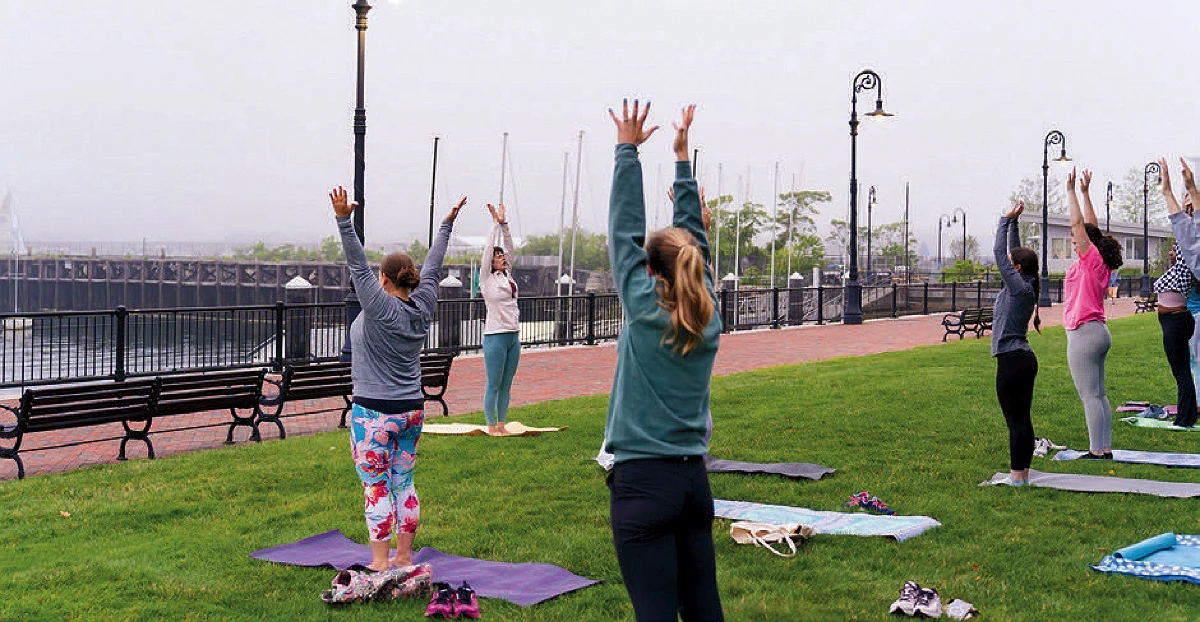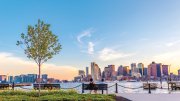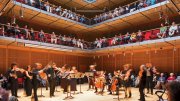Unlike other college students who waitressed for cash over the summer, Kathy Abbott, MC/M.P.A. ’88, managed Boston Harbor’s Gallups Island, where she lived for days at a time in 1979. “I’d be there at night after everyone had left and sit up on top of a little bluff looking back at the city—3.5 million people living in metro Boston and I’m on this island all by myself!” she says. “It was incredible to see this wonderful harbor, and all the other islands, then turn around and look east at Boston Light and beyond that the Atlantic Ocean.”
Some 46 years later—following the multi-billion-dollar harbor cleanup—Abbott is the president and CEO of Boston Harbor Now, where she plays an integral role in protecting and promoting that “unique resource” that so inspired her. The nonprofit agency helps ensure the waterfront is accessible, works with public and private groups to combat the effects of climate change, and hosts events, like sunset clam bakes and an East Boston festival. “The harbor and islands are such an incredible way to connect people to nature and understand their impact on nature,” Abbott says. “It’s our goal to have the harbor once again become the heart of the city.”
Following the passage of the Clean Water Act in 1972, a 1985 federal court order spurred the massive cleanup, which took decades, leading to the full opening of the Deer Island Wastewater Treatment Plant in 2000 (now combined with a terrific park, with pedestrian and bike paths, and stunning views).
So, where pollution once meant Abbott couldn’t see her hand when she dipped it into the ocean, she can now watch people fishing, swimming, and spotting fish and crabs amid clear waters. “It still makes me cry,” she says, “because when I was out there, the harbor water was disgusting.”
Technically, the harbor extends from Salem in the north down to Hull, encompassing 50 square miles of water and 34 islands and peninsulas (which comprise the Boston Harbor Islands National and State Park). This summer, find countless ways to enjoy the metro area’s 47 miles of shoreline and get out on the water and islands.
Most notable is the Boston Harborwalk, a 43-mile, nearly contiguous path (a work in progress) that snakes along the waterfront, from lower Dorchester to Logan Airport in East Boston. Dip into different sections of it, perhaps starting on the Neponset River Greenway. The bike and pedestrian path meanders through marshlands and beaches, and includes Pope John Paul II Park in Dorchester (once a landfill).

Further north, the Boston Harborwalk encompasses Castle Island and Carson Beach. Take the causeway route around Pleasure Bay, swim, play games, or just snooze on the lawn amid ocean breezes. Check the Boston Harbor Now site for yoga, fitness, and other gatherings, or take a weekend tour of Fort Independence. The granite behemoth is the latest iteration of defense structures that have been on that site since 1643.
In the Seaport District, take the Boston Harborwalk along Fan Pier Park and to the Institute of Contemporary Art (ICA). The museum hosts the Harborwalk Sounds series with bands from Berklee College of Music. On Fridays people gather to groove on disco, house, and Latin tunes spun by record-playing DJs—all with sunset views and free gallery admission tickets (reservable the same day).
The walk also curves through Boston’s downtown wharves, so you can stroll from South Station into the North End. Visit the New England Aquarium and go to Long Wharf, where boats lead to various locales. The MBTA runs year-round ferries to the Charlestown Navy Yard (site of the USS Constitution) and to the South Shore communities of Quincy, Hingham, and Hull (for a day trip to Nantasket Beach). Ferries also head to East Boston, landing at Lewis Wharf (a short walk from the MBTA’s Blue Line Maverick station), where it’s easy to join in Eastie Week activities (July 13-27). The annual event, organized by Boston Harbor Now, celebrates the people, history, culture, and arts of East Boston through events from kayaking, yoga, and poetry readings to concerts, movies, and dance classes. Walk to nearby Piers Park, stopping for Nutella waffles or an acai bowl at Aloe Natural, before heading to Massport Harbor Park, the closest you’ll get to the thrill of planes roaring overhead at Logan Airport.
Back between Lewis Wharf and Pier Park is Tall Ship Boston, a 245-foot vessel-cum-oyster-bar with games and music. Water taxis run from there to Charlestown’s Pier 6 restaurant and marina—and to the Seaport’s Fan Pier Reelhouse Oyster Bar. “So, you can get on that shuttle,” Abbott notes, “and pretty much go around the whole harbor” for a fun night out: “What other city has this?”

Another unheralded asset? The Harbor Islands. Under the aegis of the Boston Harbor Islands National and State Park, these partially drowned drumlins have also been cleaned up for recreational and educational use. On Fridays and Saturdays this summer, park rangers and U.S. Coast Guard volunteers lead two-hour Lighthouse Cruises featuring the iconic Long Island Head Light and the Boston and Graves Lights, their histories, and their roles in harbor defense. Through October 13, ferries leave from Long Wharf for three islands. On Georges Island you can take ranger-led tours and see the historic Fort Warren. Peddocks Island is much wilder: go for a day of hiking, exploring, and birdwatching. “Only a 35-minute ride on the water from downtown Boston,” says Abbott, “and it feels like you’re in a slice of Maine.” Spectacle Island offers trails, swimming beaches, and nature programs, along with special events. Boston Harbor Now hosts a Sunset Prosecco Picnic (July 17 and 31) and Sunset Lobster Clambake (July 24, August 7, and August 21). Both include roundtrip ferry rides and access to trails, beaches, and stellar vistas into the evening. Capping off the summer, Illuminate the Harbor draws people to Christopher Columbus Waterfront Park on August 28 for a fireworks extravaganza. “What’s unique is that so much of the waterfront is accessible to everybody and that there are lots of things to do on it and around it,” Abbott says. The waterfront runs throughout diverse neighborhoods and retail sectors and includes historic areas, greenways, and modern developments. Along the Boston Harborwalk are restaurants, museums, sites of the American Revolution, and artists’ studios. “And in the middle of it all is a park—with 34 islands and peninsulas. Are enough people getting downtown and on the waterfront, out on the water, and going to the islands? Essentially, no,” says Abbott. “It’s the frustration of my life. I mean, come on, people, this is all good stuff!”









